人教新目标九年级英语 Unit 10 You're supposed to shake hands教学设计(教案)(表格,共6个课时)
文档属性
| 名称 | 人教新目标九年级英语 Unit 10 You're supposed to shake hands教学设计(教案)(表格,共6个课时) | 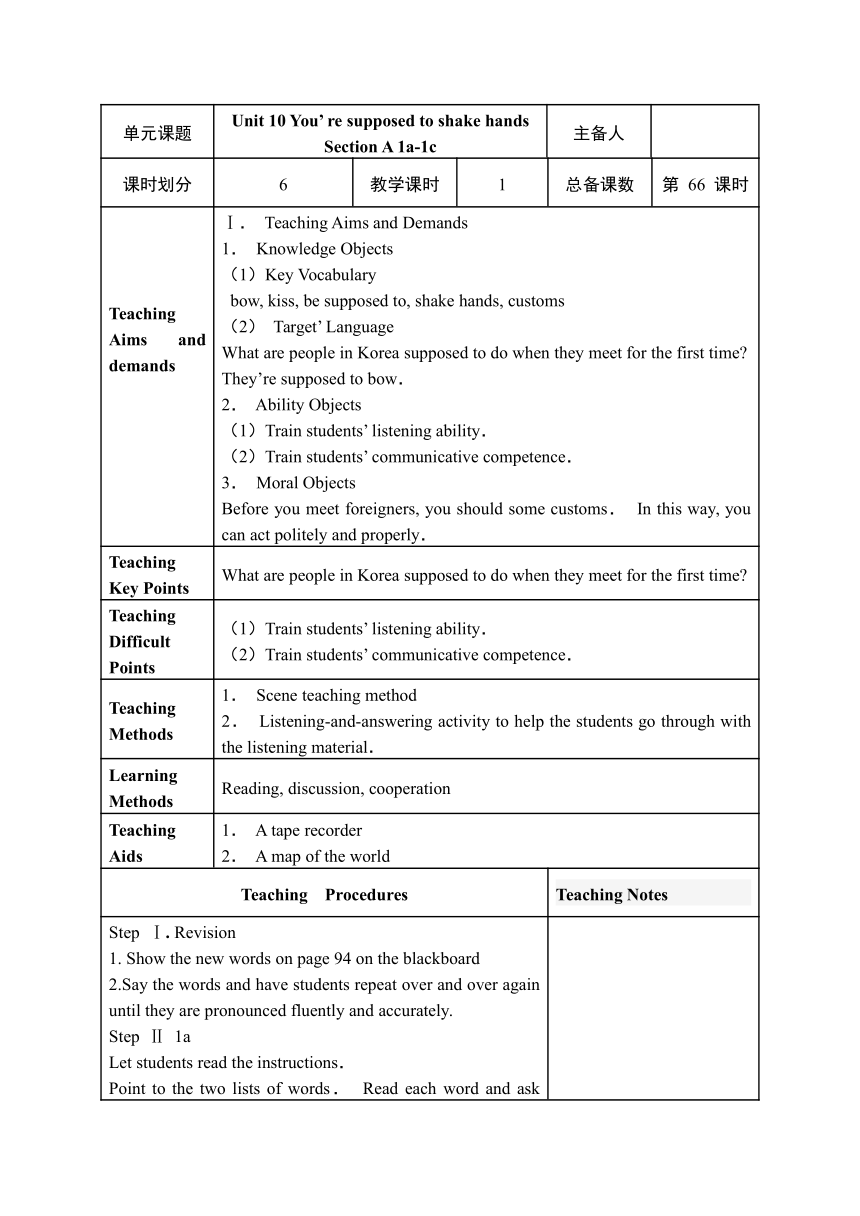 | |
| 格式 | zip | ||
| 文件大小 | 106.0KB | ||
| 资源类型 | 教案 | ||
| 版本资源 | 人教新目标(Go for it)版 | ||
| 科目 | 英语 | ||
| 更新时间 | 2021-11-12 15:37:55 | ||
图片预览

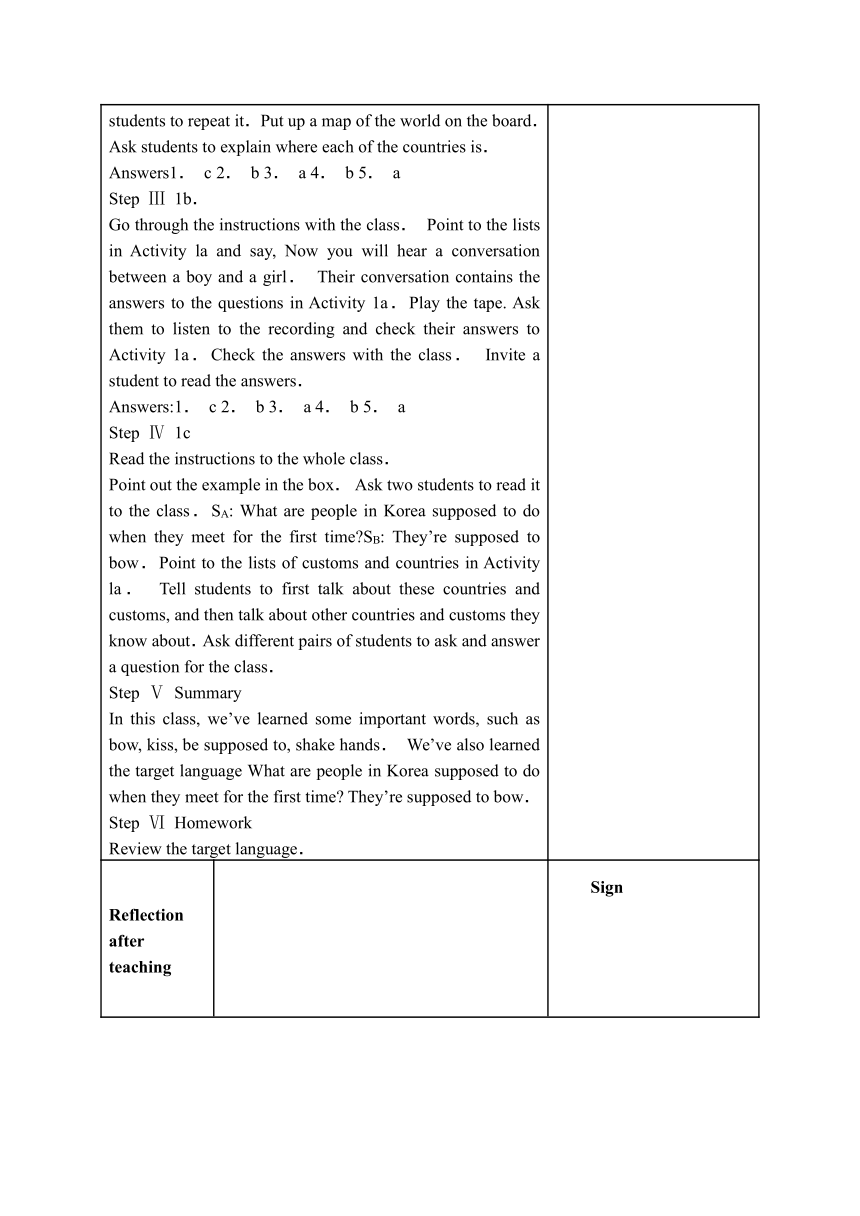
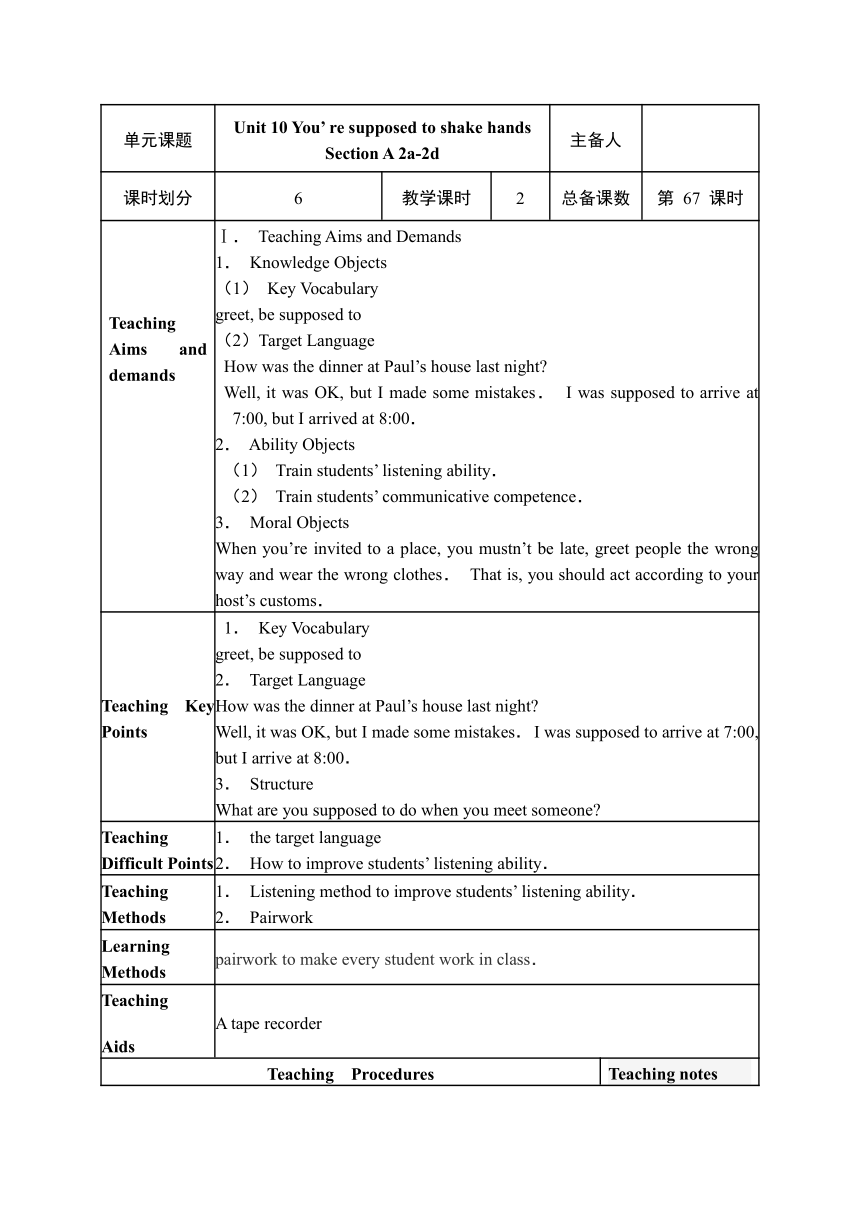
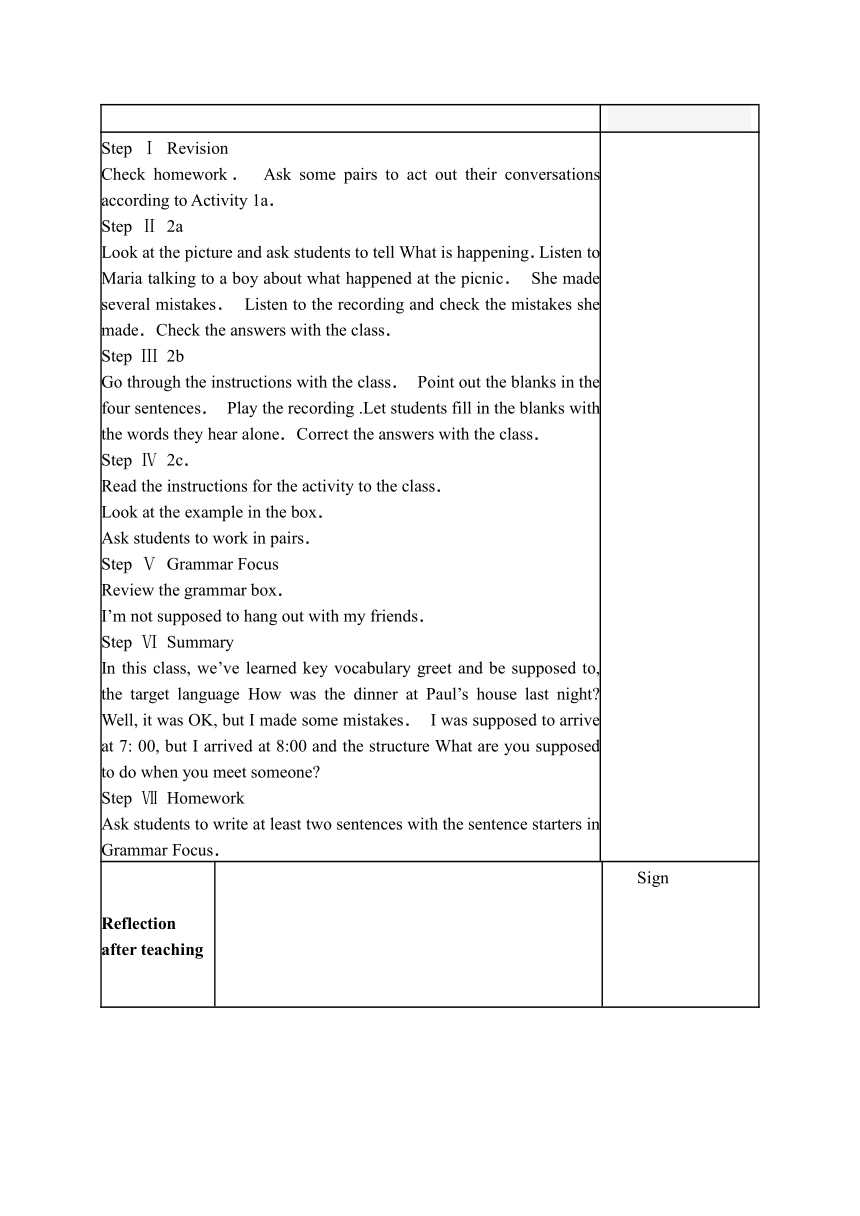
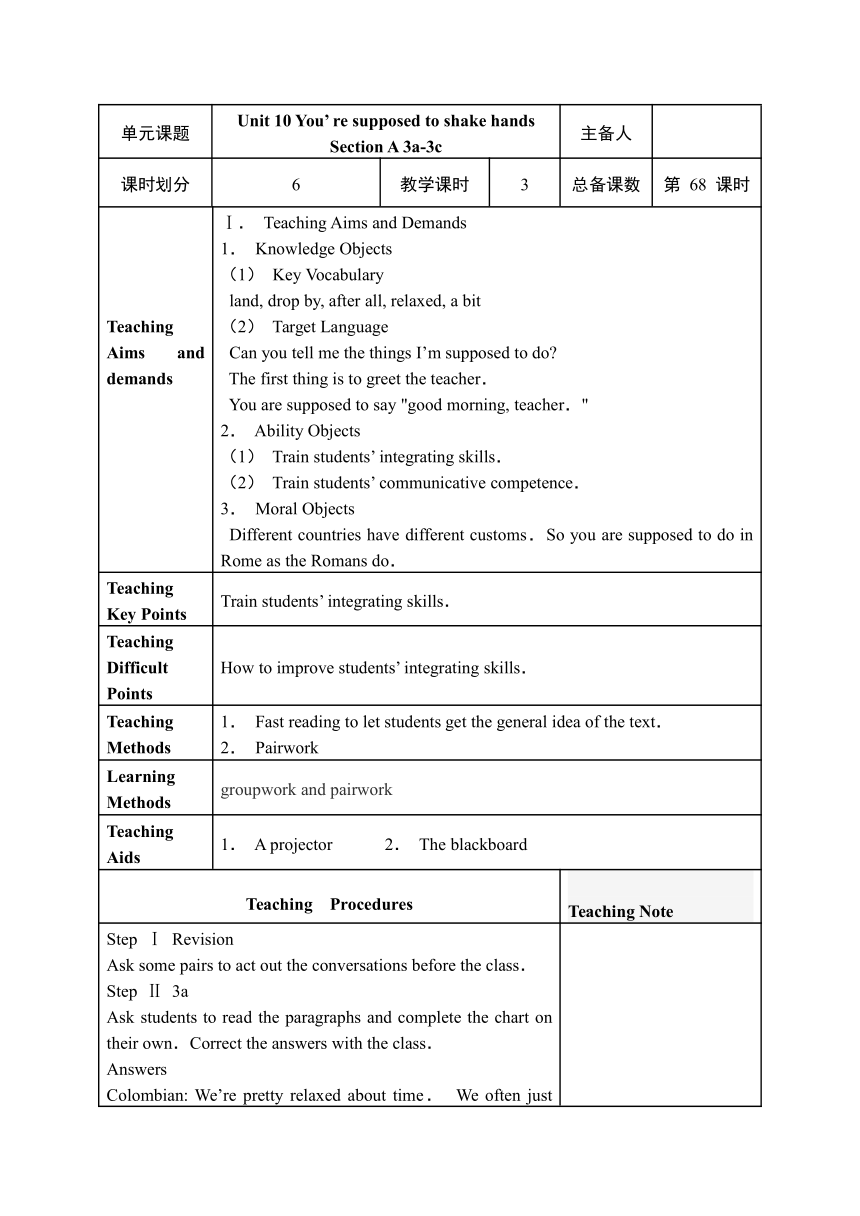
文档简介
单元课题 Unit 10 You’ re supposed to shake handsSection A 1a-1c 主备人
课时划分 6 教学课时 1 总备课数 第 66 课时
TeachingAims and demands Ⅰ. Teaching Aims and Demands1. Knowledge Objects(1)Key Vocabulary bow, kiss, be supposed to, shake hands, customs (2) Target’ LanguageWhat are people in Korea supposed to do when they meet for the first time They’re supposed to bow.2. Ability Objects(1)Train students’ listening ability.(2)Train students’ communicative competence.3. Moral ObjectsBefore you meet foreigners, you should some customs. In this way, you can act politely and properly.
Teaching Key Points What are people in Korea supposed to do when they meet for the first time
Teaching Difficult Points (1)Train students’ listening ability.(2)Train students’ communicative competence.
Teaching Methods 1. Scene teaching method2. Listening-and-answering activity to help the students go through with the listening material.
Learning Methods Reading, discussion, cooperation
TeachingAids 1. A tape recorder2. A map of the world
Teaching Procedures Teaching Notes
Step Ⅰ. Revision1. Show the new words on page 94 on the blackboard2.Say the words and have students repeat over and over again until they are pronounced fluently and accurately.Step Ⅱ 1aLet students read the instructions.Point to the two lists of words. Read each word and ask students to repeat it.Put up a map of the world on the board.Ask students to explain where each of the countries is.Answers1. c 2. b 3. a 4. b 5. aStep Ⅲ 1b.Go through the instructions with the class. Point to the lists in Activity la and say, Now you will hear a conversation between a boy and a girl. Their conversation contains the answers to the questions in Activity 1a.Play the tape. Ask them to listen to the recording and check their answers to Activity 1a.Check the answers with the class. Invite a student to read the answers.Answers:1. c 2. b 3. a 4. b 5. aStep Ⅳ 1cRead the instructions to the whole class.Point out the example in the box. Ask two students to read it to the class.SA: What are people in Korea supposed to do when they meet for the first time SB: They’re supposed to bow.Point to the lists of customs and countries in Activity la. Tell students to first talk about these countries and customs, and then talk about other countries and customs they know about.Ask different pairs of students to ask and answer a question for the class.Step Ⅴ SummaryIn this class, we’ve learned some important words, such as bow, kiss, be supposed to, shake hands. We’ve also learned the target language What are people in Korea supposed to do when they meet for the first time They’re supposed to bow.Step Ⅵ HomeworkReview the target language.
Reflection after teaching Sign
单元课题 Unit 10 You’ re supposed to shake handsSection A 2a-2d 主备人
课时划分 6 教学课时 2 总备课数 第 67 课时
TeachingAims and demands Ⅰ. Teaching Aims and Demands1. Knowledge Objects(1) Key Vocabularygreet, be supposed to(2)Target LanguageHow was the dinner at Paul’s house last night Well, it was OK, but I made some mistakes. I was supposed to arrive at 7:00, but I arrived at 8:00.2. Ability Objects (1) Train students’ listening ability. (2) Train students’ communicative competence.3. Moral ObjectsWhen you’re invited to a place, you mustn’t be late, greet people the wrong way and wear the wrong clothes. That is, you should act according to your host’s customs.
Teaching Key Points 1. Key Vocabularygreet, be supposed to2. Target LanguageHow was the dinner at Paul’s house last night Well, it was OK, but I made some mistakes. I was supposed to arrive at 7:00, but I arrive at 8:00.3. StructureWhat are you supposed to do when you meet someone
Teaching Difficult Points 1. the target language2. How to improve students’ listening ability.
Teaching Methods 1. Listening method to improve students’ listening ability.2. Pairwork
Learning Methods pairwork to make every student work in class.
TeachingAids A tape recorder
Teaching Procedures Teaching notes
Step Ⅰ RevisionCheck homework. Ask some pairs to act out their conversations according to Activity 1a.Step Ⅱ 2aLook at the picture and ask students to tell What is happening.Listen to Maria talking to a boy about what happened at the picnic. She made several mistakes. Listen to the recording and check the mistakes she made.Check the answers with the class.Step Ⅲ 2bGo through the instructions with the class. Point out the blanks in the four sentences. Play the recording .Let students fill in the blanks with the words they hear alone.Correct the answers with the class.Step Ⅳ 2c.Read the instructions for the activity to the class.Look at the example in the box. Ask students to work in pairs. Step Ⅴ Grammar FocusReview the grammar box. I’m not supposed to hang out with my friends.Step Ⅵ SummaryIn this class, we’ve learned key vocabulary greet and be supposed to, the target language How was the dinner at Paul’s house last night Well, it was OK, but I made some mistakes. I was supposed to arrive at 7: 00, but I arrived at 8:00 and the structure What are you supposed to do when you meet someone Step Ⅶ HomeworkAsk students to write at least two sentences with the sentence starters in Grammar Focus.
Reflection after teaching Sign
单元课题 Unit 10 You’ re supposed to shake handsSection A 3a-3c 主备人
课时划分 6 教学课时 3 总备课数 第 68 课时
TeachingAims and demands Ⅰ. Teaching Aims and Demands1. Knowledge Objects(1) Key Vocabulary land, drop by, after all, relaxed, a bit(2) Target Language Can you tell me the things I’m supposed to do The first thing is to greet the teacher. You are supposed to say "good morning, teacher."2. Ability Objects(1) Train students’ integrating skills.(2) Train students’ communicative competence.3. Moral Objects Different countries have different customs.So you are supposed to do in Rome as the Romans do.
Teaching Key Points Train students’ integrating skills.
Teaching Difficult Points How to improve students’ integrating skills.
Teaching Methods 1. Fast reading to let students get the general idea of the text.2. Pairwork
Learning Methods groupwork and pairwork
TeachingAids 1. A projector 2. The blackboard
Teaching Procedures Teaching Note
Step Ⅰ RevisionAsk some pairs to act out the conversations before the class.Step Ⅱ 3aAsk students to read the paragraphs and complete the chart on their own.Correct the answers with the class.AnswersColombian: We’re pretty relaxed about time. We often just drop by our friends’ home. We don’t have to make plans when we get together with friends.Switzerland: It’s very important to be on time. We never visit a friend’s house without calling first. We usually make plans to meet friends.Step Ⅲ 3bGo through the instructions for the activity with the class.Look at the example in the box. Ask two students to read the conversation to the class.Use true information.Have students work in pairs.Ask some different pairs to say their conversations to the class.Step Ⅳ Part 4.Ask a pair of students to model the sample dialogue. Get students to complete the work in pairs. As they work, walk around the classroom offering help as needed.Review the task. Ask a few students to share their conversations with the whole class.Step Ⅴ SummaryIn this class, we’ve learned some key vocabulary words land, drop by and after all, and the target language Can you tell me the things I’m supposed to do Step Ⅵ Homework1. Write a conversation using the information in Part 4.2. Finish off the exercises on pages 49~50 of the workbook
Reflection after teaching Sign
单元课题 Unit 10 You’ re supposed to shake hands 主备人
课时划分 6 教学课时 4 总备课数 第 69 课时
TeachingAims and demands Ⅰ. Teaching Aims and Demands1. Knowledge Objects(1) Key Vocabulary wipe, napkin, stick, chopstick, rude, point, pick up(2) Target Language We’re supposed to eat with chopsticks. Yes, and it’s rude to eat with our hands.2. Ability Objects(1) Train students’ listening ability.(2) Train students’ ability to understand the target language in spoken conversation.(3) Train students’ ability to use the target language.3. Moral ObjectsIn order to behave politely at the dinner table, you’re supposed to learn some table manners.
Teaching Key Points We’re supposed to eat with chopsticks. Yes, and it’s rude to eat with our hands
Teaching Difficult Points 1. Flow to improve students’ listening ability.2. How to use the target language
Teaching Methods 1. Listening method2. Pairwork
Learning Methods A tape recorder
TeachingAids A tape recorder
Teaching Procedures Teaching Notes
Step Ⅰ RevisionCheck homework. Get some students to read out their conversations using the target language in Section A 4. Step Ⅱ Part 1Review the five statements to be sure students understand what each one means. Ask students to act out them.Then ask students to complete the quiz on their own.Correct the answers with the class.Answers 1. T 2. F 3. F 4. F 5. TStep Ⅲ 2aReview what an exchange student is and what table manners are. Look at the four pictures. You will hear the exchange student Steve, talking with his Japanese friend, Satoshi.Play the recording .As they listen to the recording this time, let students number the pictures.Correct the answers with the class.Answers 2 1 4 3Step Ⅳ 2bCheck the answers with the class.Answers 1. d 2. a 3. b 4. cStep Ⅴ 2cAsk two students to read the sentence starters.complete each one with a true statement about table manners in your country. Have students work in pairs. Ask one or two pairs of students to say their conversations to the class.Step Ⅵ SummaryIn this class, we’ve learned some key vocabulary, such as wipe, rude, point, pick up. We’ve also learned the target language by listening and speaking.Step Ⅶ HomeworkTalk about the table manners in your country using the sentence starters in Activity 2b.
Reflection after teaching Sign
单元课题 Unit 10 You’ re supposed to shake hands 主备人
课时划分 6 教学课时 5 总备课数 第70课时
TeachingAims and demands Ⅰ. Teaching Aims and Demands1. Knowledge Objects (1) Key Vocabulary table manners, behave, be/get used to, cut up, full, fork, You should… (2) Practise reading an article. (3) Practise writing something using the target language.2. Ability Objects (1)Train students’ reading ability. (2)Train students’ writing ability.3. Moral Objects With the development of society, table manners are more and more important. Sometimes they can help people succeed. So you have to learn more table manners.
Teaching Key Points Practise reading and writing using the target language.
Teaching Difficult Points How to write an e-mail message.
Teaching Methods 1. Reading comprehension to help students grasp the main idea of the text.2. Writing method
Learning Methods
TeachingAids 1. A projector2. The blackboard
Teaching Procedures Teaching Notes
Step Ⅰ RevisionReview the target language presented in this unit. Check homework.Step Ⅱ 3aNow read the e-mail. Answer the questions in your exercise book. Check the answers with the class.Notes1. go out of one’s way = make a special effort2. cut up= cut into piecesStep Ⅲ 3bRead the instructions to the class. Point to the beginning of the e-mail message.Read it to the class.Here are some things you need to know about table manners when you visit Japan. Look back at the pictures in Activity 2a and the matching exercise in Activity 2b.You can use the pictures and information in Activities 2a and 2b to help you write your letters.Check the answers with the class. Ask a student to read his completed article to the class.Step Ⅳ 3cRead the instructions and ask students to look back at Activity 2c.Remind students that they made conversations about table manners in their own country.Step Ⅴ Part 4Go through the instructions with the class. Get students to complete the work in small groups.Cheek the answers. Step Ⅵ SummaryIn this class, we’ve done a lot of reading, writing and speaking practice using the target language.Step Ⅶ Homework1. Read the e-mail message in Activity 3a again.2. Write an e-mail message to a friend about table manners.
Reflection after teaching Sign
单元课题 Unit 10 You’ re supposed to shake hands 主备人
课时划分 6 教学课时 6 总备课数 第 71 课时
TeachingAims and demands Ⅰ. Teaching Aims and Demands1. Knowledge Objects(1) Fill in blanks and make sentences using arrive, meet, spend, behave and imagine.(2) Finish the story.(3) Complete the crossword.2. Ability ObjectsTrain students’ writing ability.3. Moral ObjectsYou are supposed to learn much more table manners, It is very useful and helpful, especially when you are in foreign countries.
Teaching Key Points 1. Fill in blanks and make sentences.2. Finish the story.
Teaching Difficult Points 1. Make sentences using arrive, meet, spend, behave and imagine.2. Finish the story.
Teaching Methods 1. Teaching by explanation.2. Speaking method
Learning Methods
TeachingAids 1. The blackboard2. A projector
Teaching Procedures Teaching Notes
Step 1.Finish off self check.Step Ⅱ Part 1Read the title Parent helps child to the class. Ask, What do you think the article is about, based on the title Look at the picture. Ask students to describe what is happening in the picture.Step Ⅲ Part 2Go through the instructions with the class.Ask students to complete the task individually or in pairs. Make sure students discuss their reasons in English. Step Ⅳ Part 3Look at the story. Go through the instructions with the students and have them look at the example. Ask students to complete the next word on the list on the left. Students are matching words to meanings. As they work, walk around the classroom offering help as necessary. Students complete the task. Remind them to look at the story again for extra help.Have students report their answers. Step Ⅴ Part 4Go through the task with students. Elicit the first answer from students from memory. Check that they understand what they need to do.Step Ⅵ Part 5Read the instructions with the students.Divide the class into small groups to do the activity. Give students help thinking of different fun and educational activities. Cheek the answers. Have students share their answers with the class.Step Ⅶ SummaryIn this class, we’ve practised a lot of reading and writing.Step Ⅷ Homework1. Read the story in Activity 2 again for further comprehension.2. Revise the target language in this unit.
Reflection after teaching Sign
课时划分 6 教学课时 1 总备课数 第 66 课时
TeachingAims and demands Ⅰ. Teaching Aims and Demands1. Knowledge Objects(1)Key Vocabulary bow, kiss, be supposed to, shake hands, customs (2) Target’ LanguageWhat are people in Korea supposed to do when they meet for the first time They’re supposed to bow.2. Ability Objects(1)Train students’ listening ability.(2)Train students’ communicative competence.3. Moral ObjectsBefore you meet foreigners, you should some customs. In this way, you can act politely and properly.
Teaching Key Points What are people in Korea supposed to do when they meet for the first time
Teaching Difficult Points (1)Train students’ listening ability.(2)Train students’ communicative competence.
Teaching Methods 1. Scene teaching method2. Listening-and-answering activity to help the students go through with the listening material.
Learning Methods Reading, discussion, cooperation
TeachingAids 1. A tape recorder2. A map of the world
Teaching Procedures Teaching Notes
Step Ⅰ. Revision1. Show the new words on page 94 on the blackboard2.Say the words and have students repeat over and over again until they are pronounced fluently and accurately.Step Ⅱ 1aLet students read the instructions.Point to the two lists of words. Read each word and ask students to repeat it.Put up a map of the world on the board.Ask students to explain where each of the countries is.Answers1. c 2. b 3. a 4. b 5. aStep Ⅲ 1b.Go through the instructions with the class. Point to the lists in Activity la and say, Now you will hear a conversation between a boy and a girl. Their conversation contains the answers to the questions in Activity 1a.Play the tape. Ask them to listen to the recording and check their answers to Activity 1a.Check the answers with the class. Invite a student to read the answers.Answers:1. c 2. b 3. a 4. b 5. aStep Ⅳ 1cRead the instructions to the whole class.Point out the example in the box. Ask two students to read it to the class.SA: What are people in Korea supposed to do when they meet for the first time SB: They’re supposed to bow.Point to the lists of customs and countries in Activity la. Tell students to first talk about these countries and customs, and then talk about other countries and customs they know about.Ask different pairs of students to ask and answer a question for the class.Step Ⅴ SummaryIn this class, we’ve learned some important words, such as bow, kiss, be supposed to, shake hands. We’ve also learned the target language What are people in Korea supposed to do when they meet for the first time They’re supposed to bow.Step Ⅵ HomeworkReview the target language.
Reflection after teaching Sign
单元课题 Unit 10 You’ re supposed to shake handsSection A 2a-2d 主备人
课时划分 6 教学课时 2 总备课数 第 67 课时
TeachingAims and demands Ⅰ. Teaching Aims and Demands1. Knowledge Objects(1) Key Vocabularygreet, be supposed to(2)Target LanguageHow was the dinner at Paul’s house last night Well, it was OK, but I made some mistakes. I was supposed to arrive at 7:00, but I arrived at 8:00.2. Ability Objects (1) Train students’ listening ability. (2) Train students’ communicative competence.3. Moral ObjectsWhen you’re invited to a place, you mustn’t be late, greet people the wrong way and wear the wrong clothes. That is, you should act according to your host’s customs.
Teaching Key Points 1. Key Vocabularygreet, be supposed to2. Target LanguageHow was the dinner at Paul’s house last night Well, it was OK, but I made some mistakes. I was supposed to arrive at 7:00, but I arrive at 8:00.3. StructureWhat are you supposed to do when you meet someone
Teaching Difficult Points 1. the target language2. How to improve students’ listening ability.
Teaching Methods 1. Listening method to improve students’ listening ability.2. Pairwork
Learning Methods pairwork to make every student work in class.
TeachingAids A tape recorder
Teaching Procedures Teaching notes
Step Ⅰ RevisionCheck homework. Ask some pairs to act out their conversations according to Activity 1a.Step Ⅱ 2aLook at the picture and ask students to tell What is happening.Listen to Maria talking to a boy about what happened at the picnic. She made several mistakes. Listen to the recording and check the mistakes she made.Check the answers with the class.Step Ⅲ 2bGo through the instructions with the class. Point out the blanks in the four sentences. Play the recording .Let students fill in the blanks with the words they hear alone.Correct the answers with the class.Step Ⅳ 2c.Read the instructions for the activity to the class.Look at the example in the box. Ask students to work in pairs. Step Ⅴ Grammar FocusReview the grammar box. I’m not supposed to hang out with my friends.Step Ⅵ SummaryIn this class, we’ve learned key vocabulary greet and be supposed to, the target language How was the dinner at Paul’s house last night Well, it was OK, but I made some mistakes. I was supposed to arrive at 7: 00, but I arrived at 8:00 and the structure What are you supposed to do when you meet someone Step Ⅶ HomeworkAsk students to write at least two sentences with the sentence starters in Grammar Focus.
Reflection after teaching Sign
单元课题 Unit 10 You’ re supposed to shake handsSection A 3a-3c 主备人
课时划分 6 教学课时 3 总备课数 第 68 课时
TeachingAims and demands Ⅰ. Teaching Aims and Demands1. Knowledge Objects(1) Key Vocabulary land, drop by, after all, relaxed, a bit(2) Target Language Can you tell me the things I’m supposed to do The first thing is to greet the teacher. You are supposed to say "good morning, teacher."2. Ability Objects(1) Train students’ integrating skills.(2) Train students’ communicative competence.3. Moral Objects Different countries have different customs.So you are supposed to do in Rome as the Romans do.
Teaching Key Points Train students’ integrating skills.
Teaching Difficult Points How to improve students’ integrating skills.
Teaching Methods 1. Fast reading to let students get the general idea of the text.2. Pairwork
Learning Methods groupwork and pairwork
TeachingAids 1. A projector 2. The blackboard
Teaching Procedures Teaching Note
Step Ⅰ RevisionAsk some pairs to act out the conversations before the class.Step Ⅱ 3aAsk students to read the paragraphs and complete the chart on their own.Correct the answers with the class.AnswersColombian: We’re pretty relaxed about time. We often just drop by our friends’ home. We don’t have to make plans when we get together with friends.Switzerland: It’s very important to be on time. We never visit a friend’s house without calling first. We usually make plans to meet friends.Step Ⅲ 3bGo through the instructions for the activity with the class.Look at the example in the box. Ask two students to read the conversation to the class.Use true information.Have students work in pairs.Ask some different pairs to say their conversations to the class.Step Ⅳ Part 4.Ask a pair of students to model the sample dialogue. Get students to complete the work in pairs. As they work, walk around the classroom offering help as needed.Review the task. Ask a few students to share their conversations with the whole class.Step Ⅴ SummaryIn this class, we’ve learned some key vocabulary words land, drop by and after all, and the target language Can you tell me the things I’m supposed to do Step Ⅵ Homework1. Write a conversation using the information in Part 4.2. Finish off the exercises on pages 49~50 of the workbook
Reflection after teaching Sign
单元课题 Unit 10 You’ re supposed to shake hands 主备人
课时划分 6 教学课时 4 总备课数 第 69 课时
TeachingAims and demands Ⅰ. Teaching Aims and Demands1. Knowledge Objects(1) Key Vocabulary wipe, napkin, stick, chopstick, rude, point, pick up(2) Target Language We’re supposed to eat with chopsticks. Yes, and it’s rude to eat with our hands.2. Ability Objects(1) Train students’ listening ability.(2) Train students’ ability to understand the target language in spoken conversation.(3) Train students’ ability to use the target language.3. Moral ObjectsIn order to behave politely at the dinner table, you’re supposed to learn some table manners.
Teaching Key Points We’re supposed to eat with chopsticks. Yes, and it’s rude to eat with our hands
Teaching Difficult Points 1. Flow to improve students’ listening ability.2. How to use the target language
Teaching Methods 1. Listening method2. Pairwork
Learning Methods A tape recorder
TeachingAids A tape recorder
Teaching Procedures Teaching Notes
Step Ⅰ RevisionCheck homework. Get some students to read out their conversations using the target language in Section A 4. Step Ⅱ Part 1Review the five statements to be sure students understand what each one means. Ask students to act out them.Then ask students to complete the quiz on their own.Correct the answers with the class.Answers 1. T 2. F 3. F 4. F 5. TStep Ⅲ 2aReview what an exchange student is and what table manners are. Look at the four pictures. You will hear the exchange student Steve, talking with his Japanese friend, Satoshi.Play the recording .As they listen to the recording this time, let students number the pictures.Correct the answers with the class.Answers 2 1 4 3Step Ⅳ 2bCheck the answers with the class.Answers 1. d 2. a 3. b 4. cStep Ⅴ 2cAsk two students to read the sentence starters.complete each one with a true statement about table manners in your country. Have students work in pairs. Ask one or two pairs of students to say their conversations to the class.Step Ⅵ SummaryIn this class, we’ve learned some key vocabulary, such as wipe, rude, point, pick up. We’ve also learned the target language by listening and speaking.Step Ⅶ HomeworkTalk about the table manners in your country using the sentence starters in Activity 2b.
Reflection after teaching Sign
单元课题 Unit 10 You’ re supposed to shake hands 主备人
课时划分 6 教学课时 5 总备课数 第70课时
TeachingAims and demands Ⅰ. Teaching Aims and Demands1. Knowledge Objects (1) Key Vocabulary table manners, behave, be/get used to, cut up, full, fork, You should… (2) Practise reading an article. (3) Practise writing something using the target language.2. Ability Objects (1)Train students’ reading ability. (2)Train students’ writing ability.3. Moral Objects With the development of society, table manners are more and more important. Sometimes they can help people succeed. So you have to learn more table manners.
Teaching Key Points Practise reading and writing using the target language.
Teaching Difficult Points How to write an e-mail message.
Teaching Methods 1. Reading comprehension to help students grasp the main idea of the text.2. Writing method
Learning Methods
TeachingAids 1. A projector2. The blackboard
Teaching Procedures Teaching Notes
Step Ⅰ RevisionReview the target language presented in this unit. Check homework.Step Ⅱ 3aNow read the e-mail. Answer the questions in your exercise book. Check the answers with the class.Notes1. go out of one’s way = make a special effort2. cut up= cut into piecesStep Ⅲ 3bRead the instructions to the class. Point to the beginning of the e-mail message.Read it to the class.Here are some things you need to know about table manners when you visit Japan. Look back at the pictures in Activity 2a and the matching exercise in Activity 2b.You can use the pictures and information in Activities 2a and 2b to help you write your letters.Check the answers with the class. Ask a student to read his completed article to the class.Step Ⅳ 3cRead the instructions and ask students to look back at Activity 2c.Remind students that they made conversations about table manners in their own country.Step Ⅴ Part 4Go through the instructions with the class. Get students to complete the work in small groups.Cheek the answers. Step Ⅵ SummaryIn this class, we’ve done a lot of reading, writing and speaking practice using the target language.Step Ⅶ Homework1. Read the e-mail message in Activity 3a again.2. Write an e-mail message to a friend about table manners.
Reflection after teaching Sign
单元课题 Unit 10 You’ re supposed to shake hands 主备人
课时划分 6 教学课时 6 总备课数 第 71 课时
TeachingAims and demands Ⅰ. Teaching Aims and Demands1. Knowledge Objects(1) Fill in blanks and make sentences using arrive, meet, spend, behave and imagine.(2) Finish the story.(3) Complete the crossword.2. Ability ObjectsTrain students’ writing ability.3. Moral ObjectsYou are supposed to learn much more table manners, It is very useful and helpful, especially when you are in foreign countries.
Teaching Key Points 1. Fill in blanks and make sentences.2. Finish the story.
Teaching Difficult Points 1. Make sentences using arrive, meet, spend, behave and imagine.2. Finish the story.
Teaching Methods 1. Teaching by explanation.2. Speaking method
Learning Methods
TeachingAids 1. The blackboard2. A projector
Teaching Procedures Teaching Notes
Step 1.Finish off self check.Step Ⅱ Part 1Read the title Parent helps child to the class. Ask, What do you think the article is about, based on the title Look at the picture. Ask students to describe what is happening in the picture.Step Ⅲ Part 2Go through the instructions with the class.Ask students to complete the task individually or in pairs. Make sure students discuss their reasons in English. Step Ⅳ Part 3Look at the story. Go through the instructions with the students and have them look at the example. Ask students to complete the next word on the list on the left. Students are matching words to meanings. As they work, walk around the classroom offering help as necessary. Students complete the task. Remind them to look at the story again for extra help.Have students report their answers. Step Ⅴ Part 4Go through the task with students. Elicit the first answer from students from memory. Check that they understand what they need to do.Step Ⅵ Part 5Read the instructions with the students.Divide the class into small groups to do the activity. Give students help thinking of different fun and educational activities. Cheek the answers. Have students share their answers with the class.Step Ⅶ SummaryIn this class, we’ve practised a lot of reading and writing.Step Ⅷ Homework1. Read the story in Activity 2 again for further comprehension.2. Revise the target language in this unit.
Reflection after teaching Sign
同课章节目录
- Unit 1 How can we become good learners.
- Section A
- Section B
- Unit 2 I think that mooncakes are delicious!
- Section A
- Section B
- Unit 3 Could you please tell me where the restroom
- Section A
- Section B
- Unit 4 I used to be afraid of the dark.
- Section A
- Section B
- Unit 5 What are the shirts made of?
- Section A
- Section B
- Review of Units 1-5
- Unit 6 When was it invented?
- Section A
- Section B
- Unit 7 Teenagers should be allowed to choose their
- Section A
- Section B
- Unit 8 It must belong to Carla.
- Section A
- Section B
- Unit 9 I like music that I can dance to.
- Section A
- Section B
- Unit 10 You're supposed to shake hands.
- Section A
- Section B
- Review of Units 6-10
- Unit 11 Sad movies make me cry.
- Section A
- Section B
- Unit 12 Life is full of the unexpected
- Section A
- Section B
- Unit 13 We're trying to save the earth!
- Section A
- Section B
- Unit 14 I remember meeting all of you in Grade 7.
- Section A
- Section B
- Review of Units 11-14
